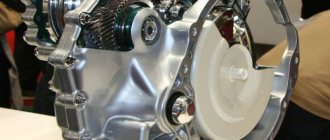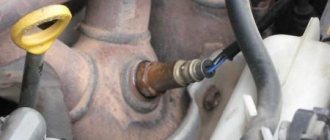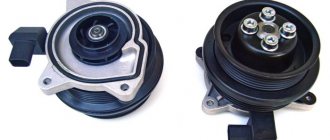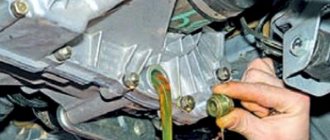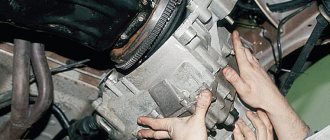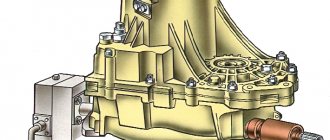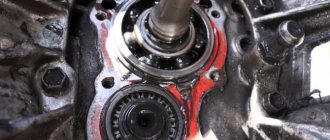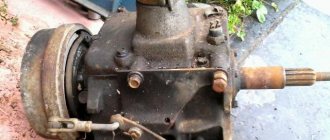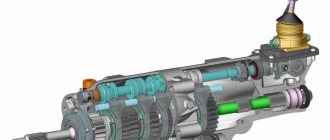Check the oil level and condition
The oil level in the variator is checked with a hot or cold box and has two marks on the dipstick. The level is checked with the car running. Before checking, you need to press the brake and hold the selector in each position for 5-10 seconds. Below is a drawing of a probe in which two intervals are visible: the hot and cold zone of the marks. The oil level should be between the marks, depending on the temperature of the box.
The oil must be light, otherwise you will have to replace it yourself (the price tag for this work with materials is approximately 15 thousand or more), the ATF should not contain inclusions of metal shavings (if the particles are visible to the naked eye, then the oil change took place without removing the oil pan, and therefore: filters were not changed, magnets were not cleaned). Also, the oil should not have a burning smell, and overheating, as everyone knows, does not extend its service life. After purchase, be sure to replace the transmission fluid by removing the crankcase as described in this manual.
Has the variator been repaired?
After checking the oil level and condition, you need to pay attention to the box fastenings. The factory marker on the bolts and nuts must be present. Pay attention to the presence of nicks and abrasions on the variator mounts. Compare the general condition of the engine compartment and gearbox; contamination should be uniform. If repairs were carried out, find out from the former owner the cause of the malfunction, and also ask for documents on the work done.
Also pay attention to whether the towbar is installed. Severe operating conditions under heavy loads contribute to increased wear and failure of the gearbox. I advise you to read the article about the correct operation of the variator
Check in motion
The deepest misconception about checking the variator is driving through an obstacle (curb) from zero speed; climbed up means the transmission is in order, but this is not so. The cones in this case remain in their previous position. At zero speed, the high-pressure oil pump does not move them apart, so you need to reach the minimum speed to overcome the obstacle. It is recommended to check the box both cold and hot; as a rule, kicks and jerks in some cases go away when the CVT warms up.
Be sure to ask the seller for a test drive of the car, in which you can feel all the shortcomings of this unit. It is also advisable to take a ride with the seller and pay attention to his driving style. The box bearings should not howl in all operating modes.
Happy shopping! And don’t forget, you can reduce the final price of a car with a CVT transmission for any deviation indicated in this article!
Did you like the article? Be sure to share with your friends.
Source: variator-cvt.ru
Driving sensations
If, when you press the gas pedal, the engine speed increases, but the speed remains the same or changes slightly, this is a bell about the “dying” state of the transmission. During smooth acceleration, the engine speed should remain approximately in the same position, and the speed should gradually increase. If there are sudden drops or overshoots in engine speed, then the gearbox is in trouble.
Important. When you smoothly brake to zero and selector position “D,” you will feel a slight kick. This is inevitable, because at this moment the torque converter is unlocked. The push should be small, barely perceptible.
When checking the car's variator in motion, if you feel kicks during acceleration or a strong push when the speed is reduced to zero, this is a sign of an emergency condition of the gearbox. This applies to Nissan CVTs and Hondas, which use a clutch pack instead of a torque converter.
Let's not forget about hearing. While driving, no crunching or grinding noises should be heard from under the hood from the gearbox side. In Qashqai, sound insulation is at a low level, so the engine compartment will be clearly audible.
Cruise control
If the car is equipped with this function, turn it on and look at the engine speed and speed. They should not twitch or remain static.
Change the speed reference. The tachometer and speedometer should change smoothly, either increase slightly or decrease. Again, jerking and kicking are not allowed.
General information about the variator
The differences between a variator and other types of gearboxes are fundamental. The defining feature is the ability to adapt to the current conditions in which the moving vehicle is located. The box also constantly determines the desired gear ratio. The gear range is limited by the design features of the transmission, but within it the number of variations is almost endless. It is this feature that helps save fuel and optimize energy costs.
There are V-belt and toroidal variators. The first ones are installed on most cars. .
How does a V-belt continuously variable transmission work?
Structurally, the CVT V-belt box is represented by two pulleys - driving and driven. The master is connected to the car engine, the slave is connected to the wheel drives. The shafts are connected using a belt or chain.
The peculiarity of the pulleys is that they look like two halves of a conical shape, their vertices directed towards each other. The divergence and convergence of the cones changes the diameter of the single structure.
The operation of the CVT is as follows. When the car starts moving, the motor experiences a load. To reduce it, the cones of the drive shaft diverge and the diameter decreases. The opposite changes occur on the driven pulley - the cones converge, the diameter increases. As a result, the number of revolutions of the internal combustion engine becomes optimal.
An increase in speed has the following effect: the diameter of the drive pulley increases, and the diameter of the driven pulley decreases. The traction force is reduced, the operation of the motor is smooth. The electronic control unit (ECU) is responsible for the convergence/divergence of the bevel pulleys. The simplicity of the design makes the CVT powertrain less expensive than other transmission options.
Smooth ride
Also quite a common problem with the variator is the appearance of jerks and jumps during operation. The cause of this breakdown is the oil pump pressure reducing valve. In some positions it begins to jam due to worn particles that pass onto the functional surface.
As a result, we have incorrect system pressure, and for this reason, the pulleys stop working smoothly and the belt begins to slip. If you catch the moment at which all this starts to happen and go to the service center as early as possible, you can polish the pulleys, however, the belt still needs to be changed, but this procedure will cost much less (60,000-80,000 rubles), than in a neglected state (more than 100,000 rubles).
Variator oil
You can try to pull out a stalled vehicle by rapidly changing the position of the lever from D to R and back, but with this method one more fact should be taken into account - the movements when moving the lever from the “parking” position to D and R. Due to this, splined wheels wear out especially badly contacts of the planetary clutches, and they interact with the friction discs.
Therefore, a pause is necessary, and optimally, stopping the car when changing from D to R and back. Otherwise, as a result of such actions, it is necessary to replace the planetary gear. Drivers often think that the reason is the valve body, but it is of very high quality for CVTs.
Technical elements of V-belt CVT
The elements of a V-belt variator include:
- clutch, which is responsible for connecting the engine with the transmission;
- torque converter;
- tapered pulleys;
- connecting chain (belt);
- an oil pump that creates the required pressure (in some cases, the operation of the cone elements is provided by hydraulics or a spring);
- a hydraulic unit that supplies oil to various parts of the drive and driven shafts;
- filters;
- radiators that take heat from the box;
- control system connected to the car's ECU;
- reverse device.
Cost of work
| Work performed | Average cost, rub | Note |
| Replacing the variator | 18000 | No price per unit |
| Belt replacement | 16000 | Belt cost included |
| Changing transmission oil and filter | 3000 | No consumables |
| Valve block repair | 18000 | |
| Dismantling/installation of the variator | 12000 | |
| Torque converter repair | 5000 | |
| Replacing the step motor of the variator | 3000 |
Diagnostics of the Nissan Qashqai variator is free, provided that repairs are carried out.
Continuously variable transmission Nissan (Jatco)
The Nissan automobile concern has developed Jatco boxes, which are now installed not only on brand models, but also on cars from other manufacturers. There are quite a lot of cars on the Russian (secondary) automobile market with a Jatco CVT, so it’s not difficult to get information about the reliability of the gearbox and their service life.
Statistics from official and independent service centers allow us to evaluate the reliability and service life of variators, the cost and feasibility of repair work, and the availability of spare parts.
When considering boxes, the emphasis will be on the CVT Nissan Qashqai, other models will also come into view. This will answer the question of whether the Nissan CVT is reliable.
CVT Nissan Qashqai j10, X-trail T31 (T32), Murano (Z50 and Z51), Teana
Jatco models JF010E and JF011E represent the second generation of continuously variable transmissions. The second is combined with 2 and 2.5 liter petrol engines, the first comes with a 3.5 liter engine. There are no differences in design; the first variator only has reinforced elements for higher torque.
The JF011E variator was installed on the Qashqai and X-Trail crossovers of the penultimate generation, as well as on the Mitsubishi Outlander (the last two generations). JF010E went to the Murano crossover (Z50 and Z51) and the Teana sedan.
The reliability of the Qashqai variator is beyond doubt, since the gearbox family in question is not distinguished by the presence of characteristic sores. The resource is about 150-200 thousand km. Once a Nissan CVT reaches the end of its life, its components are already critically worn out.
The advantage of CVTs is their maintainability. The cost of the latter is 150-180 thousand rubles. The concern produces a valve body or variator assembly for the spare parts market. You can find some spare parts on the market, others can be repaired. A new continuously variable transmission costs 200-230 thousand. If the resource allows, you need to choose this option.
Replacement with automatic
Some owners of Nissan Qashqai, especially the 1st generation, who are faced with problems and repairs of the continuously variable transmission, not wanting to further comply with many restrictions, are thinking about replacing the CVT with an automatic transmission. Automatic transmission, when compared with a CVT, has advantages:
- Increased wear resistance and reliability of electronic and mechanical components.
- Less wear and tear with sporty driving style.
- Provides the ability to confidently move off-road.
- Allows you to load the car more and tow a trailer.
Disadvantages include higher fuel consumption and slightly worse ride comfort. If the Nissan Qashqai engine is structurally compatible with an automatic transmission, then our specialists will quickly and correctly replace the gearbox.
Nissan Qashqai, checking the fluid level in the variator: how to do it yourself and not make a mistake
On a Nissan Qashqai, checking the fluid level in the variator (CVT) is easy to do yourself, anywhere and at any hour. One important condition is that the engine must be warmed up, i.e. you will have to travel at least 10 km. The thing is, the error can be too large, which will lead to wrong decisions and wrong actions. Overfilling, like underfilling oil, has its negative sides.
The fluid level is checked after warming it up to 50-80°C, i.e. in winter, the mileage before checking should be greater - up to 25 km. When taking measurements in the summer, in the heat, you should let the car sit for half an hour after the trip and cool down a little. In any case, the level should not be “cold” (after warming up the engine at idle), but rather “hot”, i.e. after running along the highway.
Checking the presence of a tow bar
No matter how strange it may sound, its presence can significantly shorten the life of a continuously variable transmission. The design feature of a V-belt variator involves transmitting torque through a belt. If the vehicle is pulling large loads: loaded trailers, motorhomes, etc., belt slippage may occur. This will already lead to scoring on the cones and expensive repairs.
Important. The seller, knowing about the problem with the tow bar, could have removed it before selling it. Therefore, before buying a used car with a CVT, look under the rear of the car to see if there are mounts for a hook.
Stages of checking the oil level in the Nissan Qashqai CVT
In order for the fluid level in the variator to be checked accurately on a Nissan Qashqai, place the car on a flat horizontal surface. The engine should be running at idle speed, i.e. Do not turn off the engine. Without releasing the brake pedal, you should sequentially move the selector through all positions - P, R, N, D. The delay in each position should be about 5-10 seconds.
After this run, you must set the selector to mode P, after which you can release the brake pedal.
Get out of the car and open the hood. You need to remove the dipstick from the variator filler neck. For those who have never done this, you should know that the neck is marked with the inscription “TRANSMISSION”, and on some modifications - CVT. To release the probe, press the lock on the probe and unlock it.
If you crawl under the hood empty-handed, you'll have to return to the car and grab a rag. The dipstick needs to be wiped dry. Make sure that there are no small particles of matter left on it. The rags must be clean and dry to prevent the ingress of dirt and water. It is better not to carry out the test during rain or snow, which can also lead to moisture getting into the liquid.
After cleaning the dipstick, it should be lowered back into the neck until it stops, leave for a short time and remove the dipstick again. Watch the latch: it should be positioned so that the probe does not snap into place. At the end of it you will see marks. They indicate the level. This is how the fluid level in the variator is checked on a Nissan Qashqai.
Normally, the liquid reaches an average value between the minimum and maximum marks marked on the surface of the dipstick, i.e. the end of the oil part is located in the hot range. If you don’t see such a mark on the dipstick, then look for marks of a different kind. It could be:
After checking, lower the dipstick back into the neck until it stops so that the latch engages. This completes the check.
If the oil level is less
If you find that your oil level is at or below a critical level, you need to urgently add fluid. For this purpose, in fact, the fluid level in the variator is checked on the Nissan Qashqai. The brand of oil, or its characteristics for choosing an analogue, is always indicated in the user manual. It is necessary to fill in oil of equivalent characteristics.
You don't have to look for a specific brand. It is important that the fluid in the system and the one being added are identical. When topping up, you should understand that overfilling is undesirable. This is why the maximum is marked on the dipstick. In order not to overfill the system, control measurements should be carried out, repeating the steps described above.
